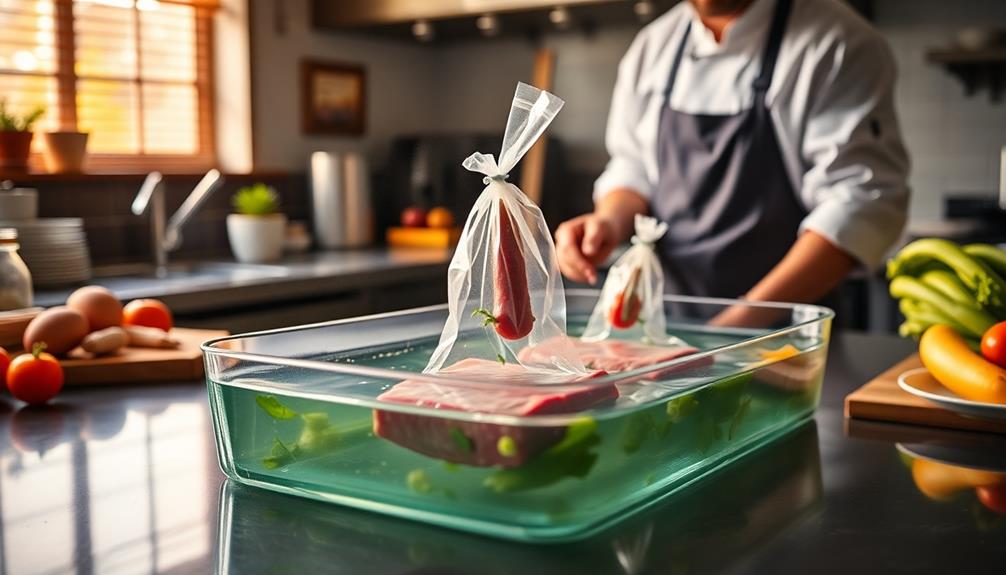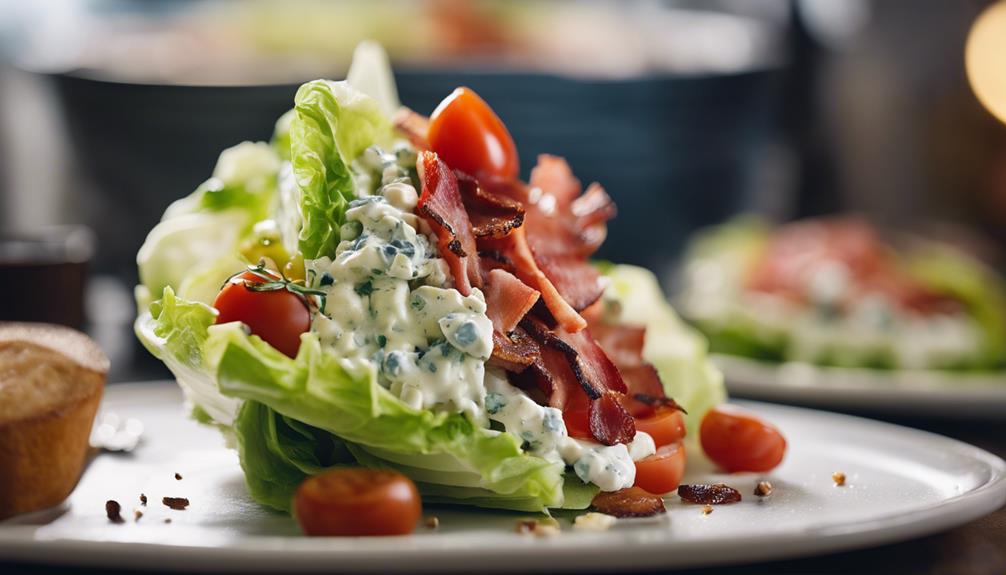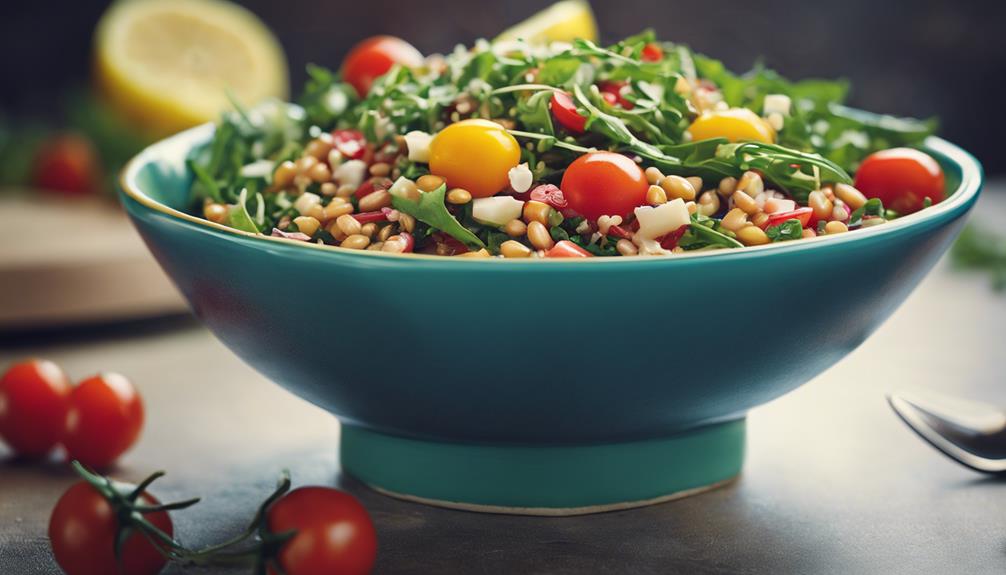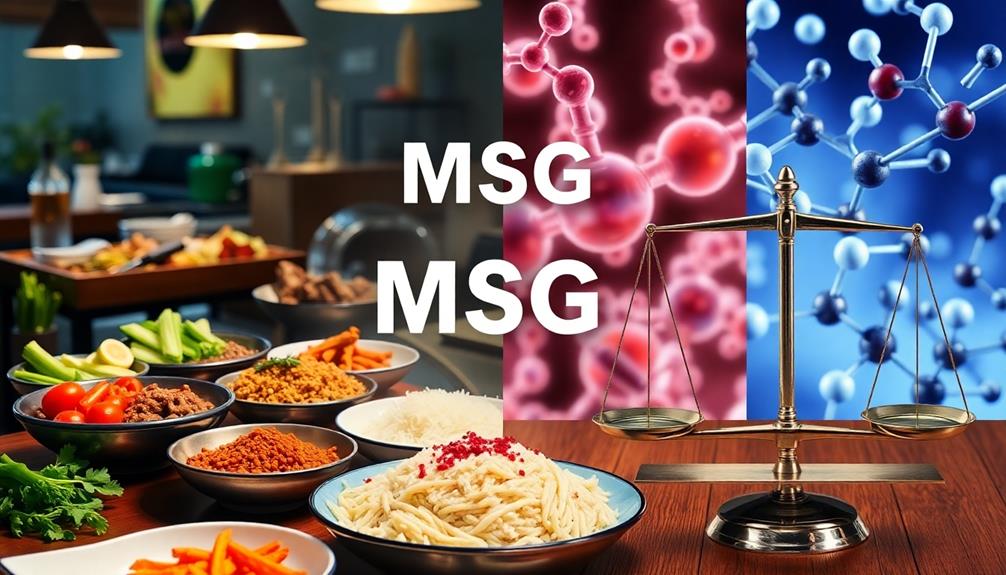Restaurants use sous vide cooking because it guarantees high-quality results with every dish. By sealing food in vacuum bags and cooking them in a controlled water bath, chefs achieve precise temperature control. This method locks in flavors and moisture, making even cheaper cuts of meat tender and delicious. It also promotes kitchen efficiency, allowing for batch cooking and easy re-heating, which is essential during busy service hours. Plus, it enhances food safety by reducing contamination risks. If you're interested in understanding more about the benefits and applications of sous vide in the culinary world, there's plenty more to explore.
Key Takeaways
- Sous vide cooking ensures precise temperature control, resulting in consistently perfect doneness for proteins and vegetables.
- The vacuum sealing process retains moisture and flavors, enhancing the taste and texture of dishes.
- Sous vide allows for batch cooking, increasing kitchen efficiency during peak hours by preparing multiple items simultaneously.
- This method extends the shelf life of prepared foods, reducing food waste and promoting food safety through controlled cooking environments.
- Restaurants can innovate with unique flavor combinations and seasonal ingredients, creating standout dishes that differentiate them from competitors.
Overview of Sous Vide Cooking
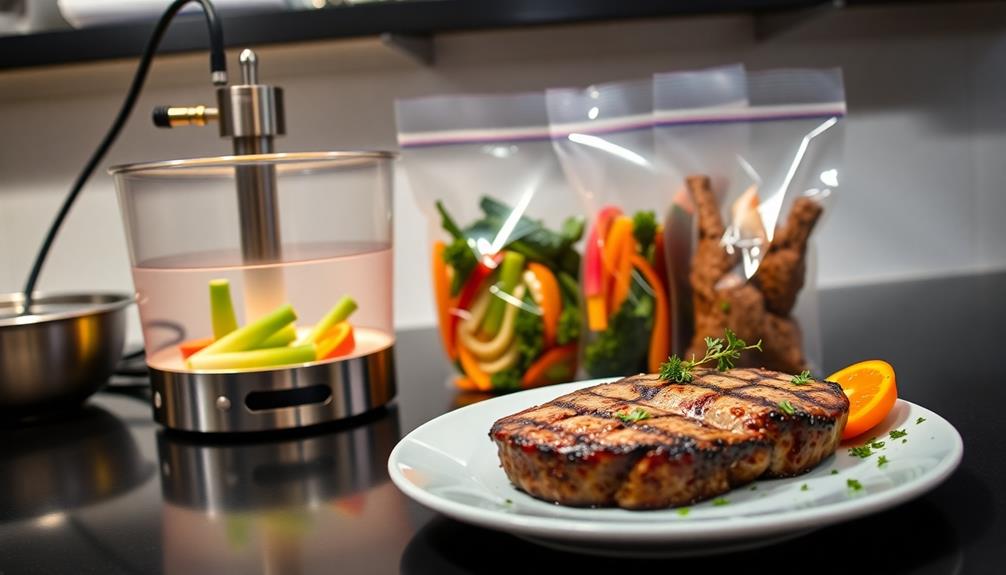
Sous vide cooking has revolutionized the way chefs approach food preparation in restaurants. This technique, meaning "under vacuum," involves sealing food in vacuum bags and immersing it in a temperature-controlled water bath. By using sous vide methods, you achieve precise temperature control, which guarantees that food cooks evenly and retains its flavors and tenderness.
This technique can be particularly useful when preparing delicate dishes like Nettle and Potato Soup or rich meats such as slow-cooked pork belly. Originally developed in the 1970s by French chefs, sous vide was designed to enhance meat cooking, but its versatility means you can use it for proteins, vegetables, and even desserts.
The cooking process allows for unattended cooking, freeing up your time in the kitchen. You won't have to worry about overcooking, as the food maintains a consistent temperature throughout its cooking period. Additionally, sous vide methods promote food safety by minimizing the risk of bacterial growth. By cooking at precise temperatures and guaranteeing even heat distribution, you can serve high-quality dishes with confidence.
With the increasing popularity of sous vide, it's clear that this method is becoming essential in both fine dining and casual restaurants alike. Embracing sous vide can elevate your culinary offerings and streamline your kitchen operations.
Key Benefits of Sous Vide
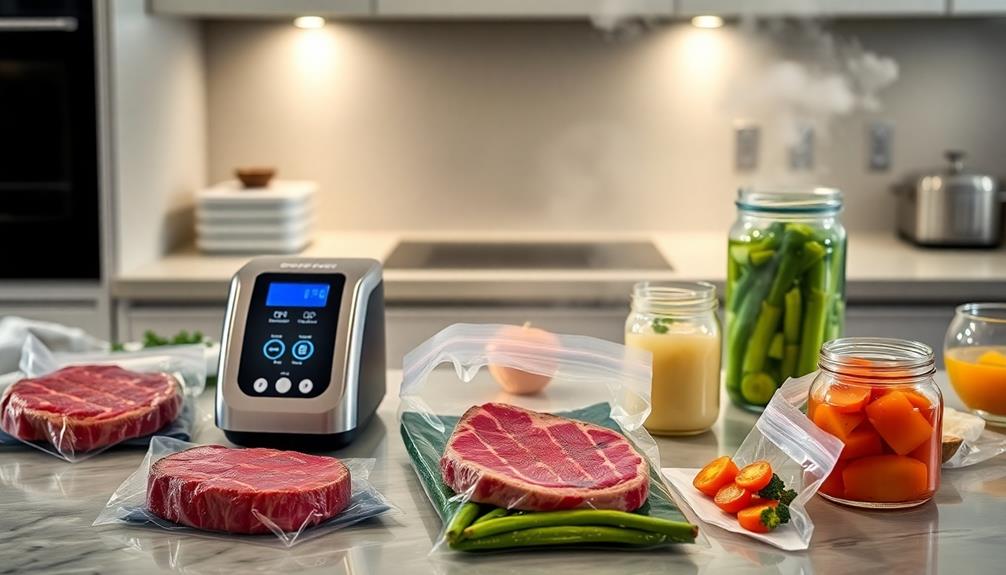
When it comes to culinary techniques, sous vide offers a range of key benefits that can transform your restaurant's kitchen operations. One of the standout advantages of sous vide cooking is its precise control over cooking temperature, ensuring that you achieve consistently perfect results. This eliminates the risk of overcooking and guarantees that your proteins and vegetables are cooked just right every time, much like how traditional Brazilian dishes rely on careful preparation to enhance flavor.
The vacuum sealing process is another game changer, as it helps retain moisture and flavors, leading to enhanced taste and texture. You'll notice that proteins become incredibly tender and juicy, making each dish unforgettable.
Plus, sous vide allows for batch cooking in a controlled environment, increasing your kitchen efficiency. You can prepare multiple dishes simultaneously without sacrificing quality, which is a huge time saver.
Moreover, the pasteurization process associated with sous vide techniques extends the shelf life of prepared foods, enhancing food safety by reducing the risk of foodborne pathogens.
Applications in Restaurant Kitchens
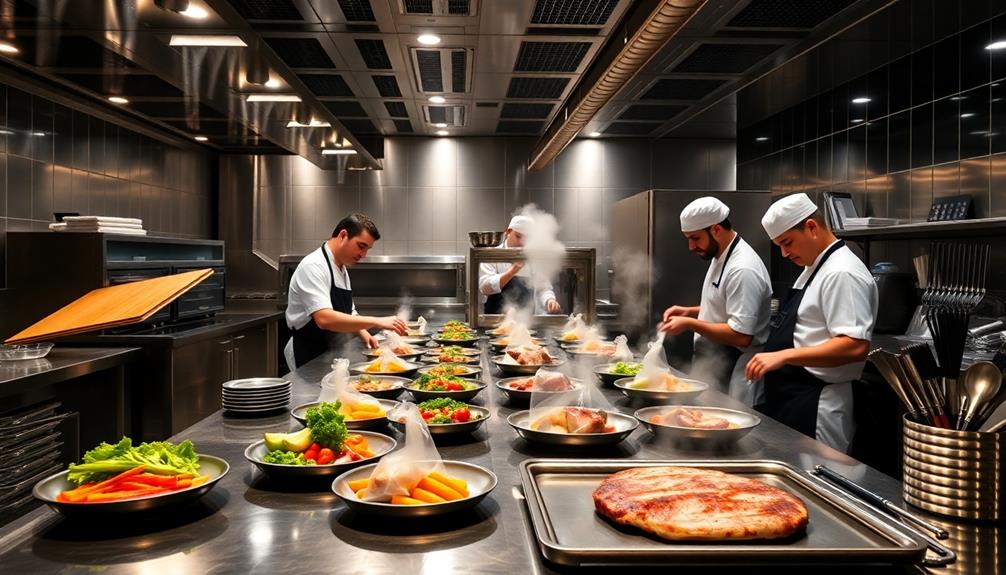
The versatility of sous vide cooking opens up a world of applications in restaurant kitchens. With sous vide technology, you can prepare proteins and vegetables with precise temperature control, ensuring consistent quality and minimizing the risk of overcooking. This method allows you to batch cook, letting multiple items simmer simultaneously at a constant temperature, which boosts efficiency during peak service times.
For instance, dishes like Mushroom Masala can be prepared in advance, ensuring that their rich blend of spices is perfectly infused.
Pre-cooking sous vide items means you can simply reheat them for service, markedly speeding up meal delivery and enhancing customer satisfaction. Plus, because vacuum-sealed items have longer shelf lives, this approach helps reduce food waste. You can portion out ingredients for future use without sacrificing quality.
Furthermore, sous vide cooking encourages creativity. It allows you to experiment with unique flavor combinations and seasonal ingredients. This innovation can lead to exciting menu offerings that attract diners looking for novel experiences.
In a professional kitchen, the ability to maintain quality and consistency while reducing waste makes sous vide an invaluable technique, transforming how you operate and delight your customers.
Cost-Effectiveness of Sous Vide
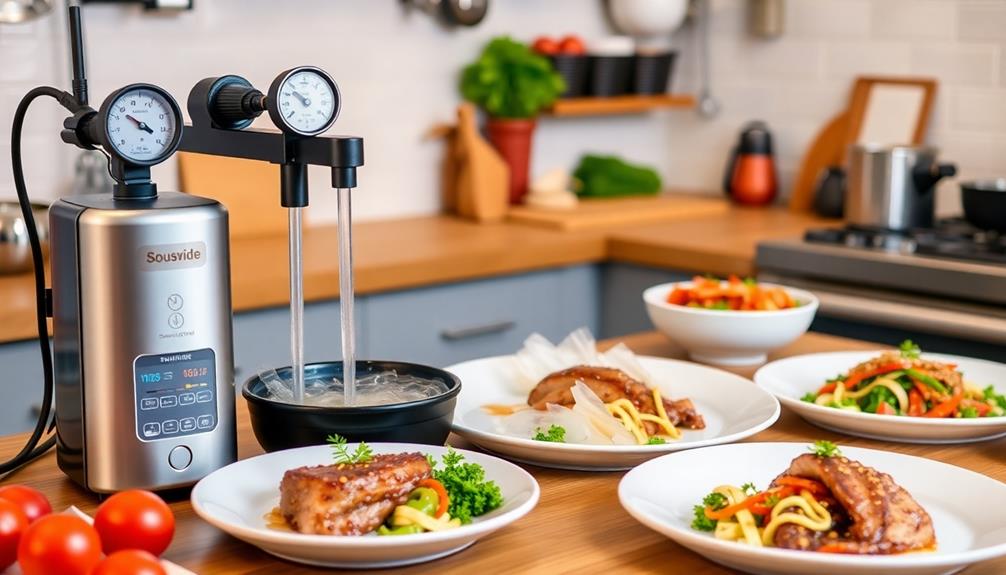
Restaurants can greatly benefit from sous vide's cost-effectiveness, as it enables the use of cheaper cuts of meat to achieve premium textures and flavors. This technique not only reduces ingredient costs but also minimizes food waste. With precise temperature control, you guarantee that food is cooked perfectly every time, leading to better yield and less spoilage. Additionally, sous vide simplifies food preparation, allowing your staff to multitask efficiently, which can considerably decrease labor costs in commercial kitchens.
You'll also appreciate the energy efficiency of sous vide cooking. It requires less energy than traditional methods, ultimately lowering your utility bills. By offering high-quality sous vide dishes, you can justify higher menu prices and increase revenue without greatly raising costs.
Here's a quick overview of the cost benefits:
| Cost Factor | Sous Vide |
|---|---|
| Ingredient Costs | Lower (cheaper cuts) |
| Food Waste | Minimized |
| Labor Costs | Reduced |
| Energy Consumption | More efficient |
| Potential Revenue | Higher menu prices |
With these advantages, sous vide cooking is a smart choice for restaurants looking to optimize their operations.
Enhancing Menu Innovation
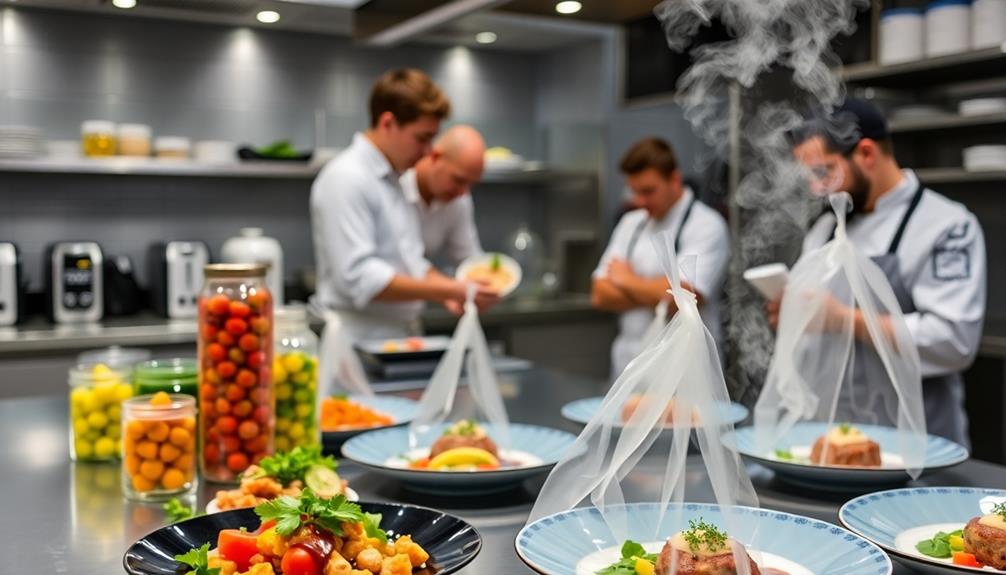
Releasing the potential of sous vide cooking can transform your menu into a canvas for innovation. This cooking technique allows you to experiment with unique flavor combinations, creating dishes that truly stand out. By harnessing the power of precise temperature control, you can guarantee consistent results, even when preparing complex meals that require meticulous attention to detail.
For instance, imagine infusing sous vide dishes with the aromatic flavors found in traditional Indonesian desserts like Kue Putu, which could add a delightful twist to your offerings.
Using sous vide, you can highlight seasonal and local ingredients, showcasing fresh produce while appealing to the growing demand for sustainable dining options. This not only enhances your culinary repertoire but also elevates the overall dining experience for your guests.
As you introduce sous vide-prepared dishes, you create signature items that differentiate your restaurant from competitors, attracting interest from both new and returning customers.
Moreover, with an increasing number of diners seeking high-quality, restaurant-style meals at home, innovative menu offerings become essential. By incorporating sous vide into your cooking, you can meet this demand while continually evolving your menu.
In short, sous vide is more than just a cooking technique; it's a gateway to endless possibilities in menu innovation, inviting you to explore exciting flavors and juices like never before.
Ensuring Food Safety
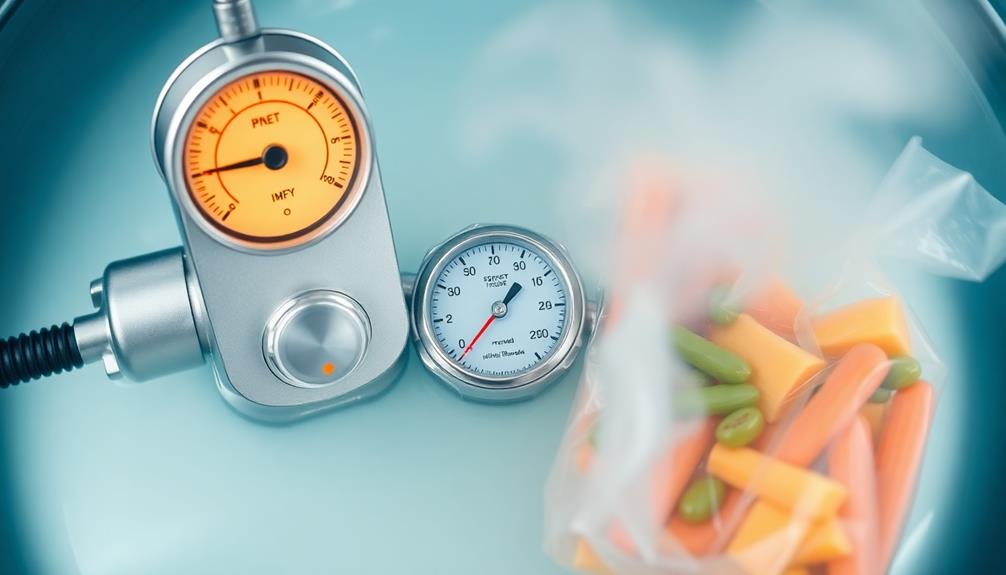
Harnessing sous vide cooking not only enhances menu innovation but also plays a vital role in ensuring food safety. By maintaining precise temperatures for specific time periods, sous vide cooking effectively reduces harmful pathogens through pasteurization. This temperature control is essential in minimizing the risk of foodborne illnesses.
The vacuum sealing process further enhances food safety by reducing exposure to air and bacteria. This notably lowers the chances of contamination during cooking and storage. Additionally, sous vide techniques can extend the shelf life of prepared foods, allowing for safer storage and reducing food waste in your kitchen.
Here's a quick overview of how sous vide contributes to food safety:
| Aspect | Benefit | Importance |
|---|---|---|
| Temperature Control | Achieves pasteurization | Reduces harmful pathogens |
| Vacuum Sealing | Minimizes exposure to air and bacteria | Lowers contamination risk |
| Shelf Life Extension | Safer storage of prepared foods | Reduces food waste |
Equipment and Setup Essentials
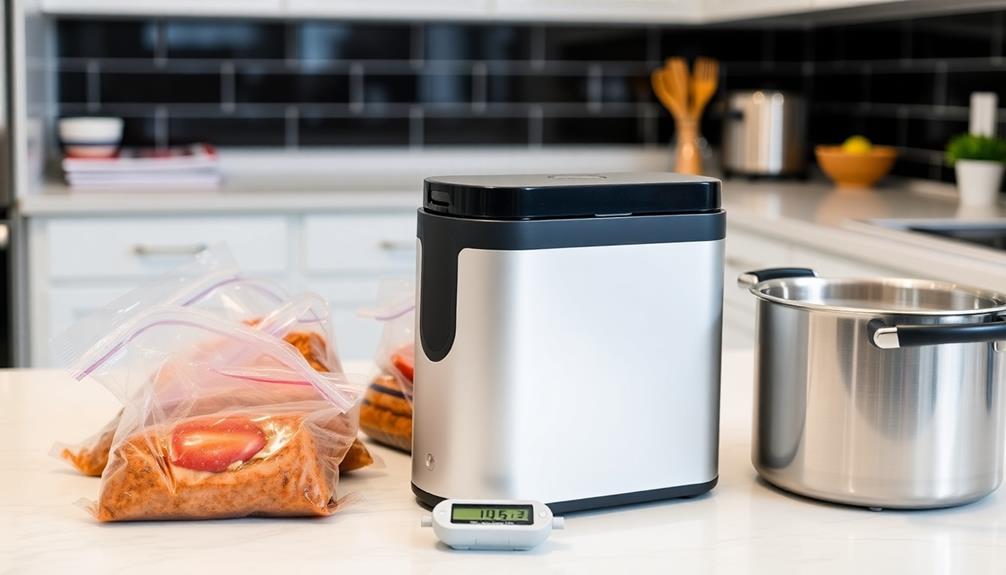
To master sous vide cooking, you need essential equipment like an immersion circulator and a reliable vacuum sealer.
This technique allows for precise temperature control, making it possible to achieve the perfect texture in dishes like Red-Braised Pork Belly.
Setting up your water bath correctly guarantees precise temperature control, while regular maintenance keeps everything running smoothly.
Let's explore the key tools and best practices that will elevate your sous vide game.
Essential Equipment Overview
Sous vide cooking in restaurants requires essential equipment that guarantees precision and safety in food preparation. The backbone of this method is the immersion circulator, which maintains a constant temperature in the water bath, ensuring your food cooks evenly and perfectly. This technique can enhance the flavors and textures of dishes like Chilaquiles, allowing for a delightful breakfast experience.
You'll also need a heat-resistant storage container to hold the water and vacuum-sealed bags, promoting effective heat transfer and food safety. A commercial vacuum sealer is important for removing air from the bags and sealing them tightly. This step prevents oxidation and enhances flavor retention during cooking.
For your sous vide bags, use polyethylene, as it's safe for heat exposure; avoid PVC wraps due to potential health risks. While the core equipment is essential, consider optional tools to elevate your sous vide experience. A pan for searing, a thermometer for monitoring water temperature, and a blow torch for finishing touches on meats can enhance both presentation and flavor.
With the right equipment, you can master sous vide cooking and deliver exceptional dishes that keep your customers coming back for more.
Setup Best Practices
Setting up your sous vide station correctly is fundamental for achieving consistent results in the kitchen. Start by verifying you have an immersion circulator, which maintains a constant temperature throughout the cooking process.
The versatility of sous vide cooking allows you to explore a wide range of culinary traditions from around the world, such as Yunnan Cross-Bridge Rice Noodles, which can be beautifully enhanced through precise temperature control. Use a heat-resistant storage container to hold your water and food bags securely.
Next, season your food and add any optional aromatics before bagging it. A commercial vacuum sealer is essential for sealing food properly; it removes air from vacuum bags made of polyethylene, guaranteeing optimal cooking results.
Remember, accurate cooking temperatures are crucial for food safety, so regularly calibrate your immersion circulator to ensure precision. Additionally, it’s important to regularly check the temperature of your water bath to make sure it matches the digital reading on your immersion circulator. Inaccurate temperatures can lead to bacteria growth and foodborne illnesses. When it comes to cooking, consider the benefits of cast iron cookware, which heats evenly and retains temperature well, making it a reliable choice for maintaining accurate cooking temperatures.
Once your food is sealed tightly, place the vacuum-sealed bag into the heated water bath. This setup allows the sous vide method to work effectively, providing even cooking for your ingredients.
After the cooking is complete, utilize a pan for searing your food to enhance both presentation and flavor. You might also consider finishing techniques, like using a blow torch, to elevate your dish further.
Following these setup best practices not only improves your results but also guarantees a safe and efficient cooking experience.
Maintenance Recommendations
Maintaining your sous vide equipment is just as important as using it correctly to guarantee high-quality results in your kitchen. Start by regularly calibrating your immersion circulator to verify accurate temperature readings, which is vital for consistent cooking.
After each use, clean the water bath container and immersion circulator to prevent bacterial growth and maintain hygiene standards. When preparing sous vide dishes, consider the precision involved in cooking items like Dorayaki (Red Bean Pancake), which requires careful temperature control for ideal texture and flavor.
When it comes to packaging, always opt for heat-resistant vacuum sealer bags made of polyethylene. Avoid using PVC wraps, as they can release harmful chemicals during cooking.
Regularly inspect your commercial vacuum sealer and its components for wear and tear, confirming reliable sealing and preventing air exposure during the sous vide process.
Storing your equipment properly is fundamental, too. Keep everything in a clean, dry area, and adhere to the manufacturer's maintenance guidelines. This will help prolong the lifespan and efficiency of your sous vide tools.
Future Trends in Sous Vide
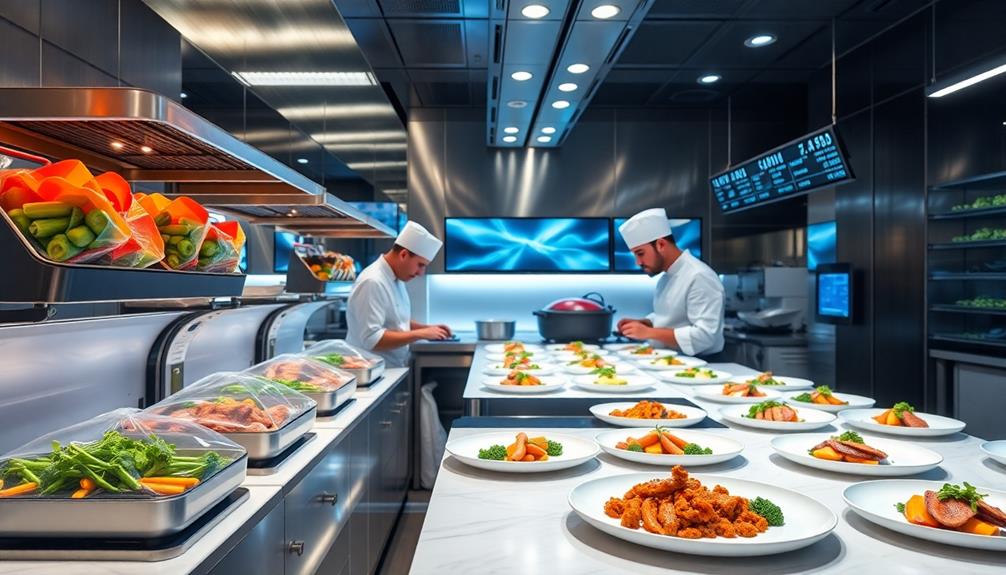
As the culinary landscape evolves, sous vide is carving a prominent niche in restaurant kitchens, blending seamlessly with traditional cooking methods to create innovative dishes.
You'll notice that the sous vide market is projected to grow considerably, with more restaurants adopting this technique to enhance their offerings. This aligns with the increasing popularity of precision cooking methods, such as making perfect pasta with tomato sauce that can be elevated through sous vide techniques.
By integrating sous vide with grilling or searing, you can achieve hybrid dishes that not only taste amazing but also look appealing on the plate.
Sustainability is another key trend driving the demand for sous vide. This method reduces food waste and energy consumption, aligning with the growing emphasis on eco-friendly practices in the culinary world.
Plus, the introduction of affordable sous vide equipment means that even casual eateries can embrace this cooking style.
Technological innovations are also reshaping sous vide cooking. With smart devices featuring app connectivity, you can streamline your cooking processes and improve efficiency in the kitchen.
As you experiment with precise time and temperature control, you'll elevate your culinary creations, ensuring consistent results that wow your guests.
The future of sous vide in restaurants looks promising, and you'll want to be part of this exciting evolution.
Frequently Asked Questions
What Do Restaurants Use Sous Vide For?
You'll find restaurants use sous vide to guarantee precise cooking, enhance flavors, and achieve consistent textures. It also allows for batch cooking and experimentation with unique ingredients, all while maintaining food safety standards.
Do Professional Chefs Use Sous Vide?
Absolutely, professional chefs use sous vide to create culinary masterpieces. You'll find them embracing this technique for precise temperature control, ensuring every dish achieves that perfect doneness, enhancing flavors, and transforming ingredients into unforgettable experiences.
What Is so Special About Sous Vide Cooking?
Sous vide cooking's special because it offers precise temperature control, ensuring your food cooks evenly. You'll lock in flavors and juices, prevent overcooking, and enjoy tender, perfectly cooked meals every time you use it.
What Is a Disadvantage of Sous Vide?
One disadvantage of sous vide is the need for specialized equipment, which can be expensive. You might also find that the long cooking times don't suit a fast-paced environment, potentially impacting service and customer satisfaction.
Conclusion
Incorporating sous vide cooking into your restaurant can be like adding a secret ingredient that elevates every dish. By embracing this technique, you'll not only enhance flavors and guarantee consistency but also streamline your kitchen operations. With its cost-effectiveness and potential for menu innovation, sous vide is a game-changer in the culinary world. As you look towards the future, this method will likely become a staple in your kitchen, helping you stay ahead of the competition.
